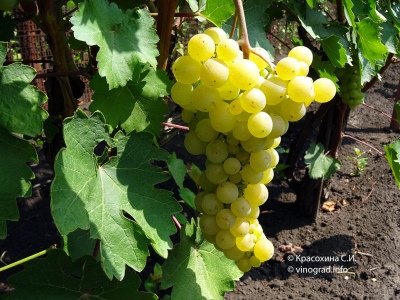
- Authors: G.E. Westminsh, Latvia
- Appointment: dining room
- Berry color: White
- Taste: harmonious, nutmeg
- Ripening period: very early
- Ripening period, days: 90
- Frost resistance, ° C: -25
- Bunch weight, g: 230-300
- Flower type: functionally female
- Density of the bunch: moderate density
Growing vines and harvesting are no longer exclusively the domain of winemakers. Today, every gardener can grow a wonderful table variety on his site. One of the most popular species is Liepajas Dzintars.
Breeding history
The described grape was developed in Latvia by the breeder G.E. Westminsh.
Geography of distribution
On the territory of Russia, as in other countries, this variety is often found, since it has a large list of advantages.
Description
Liepajas Dzintars is a table variety with functionally female flowers. If we talk about the bush itself, then it has strong growth, so regular pruning is required.
In this species, the fruiting coefficient is 0.75-0.85. The number of clusters per shoot is 1.3-1.5.
Ripening period
Liepajas Dzintars ripens in 90 days, therefore it belongs to very early varieties.
Bunches
Cylindric-conical clusters are formed on the bush. Their density can be characterized as moderate. The weight of one bunch can vary from 230 to 300 grams.
Berries
The fruits on the grapes are white. During the period of full ripeness, the sugar level is 210-240 g / dm³. The acidity is at the level of 5-6 g / dm³.
On grapes, the skin is medium in thickness. During meals, it is practically invisible. Inside the fruit is a fleshy, juicy pulp that melts in your mouth. The weight of one grape is from 4 to 5 grams. The fruits are round.
Taste
Tasters around the world evaluate the taste of this variety as nutmeg, harmonious.
Yield
The vine yields consistently. It is a high-yielding variety.


Growing features
In order for a plant to bring a good harvest, it must be watered and fertilized in a timely manner. It is best to use mulch around the vine. It not only helps to prevent the growth of weeds, but also retains moisture. This is very important in summer when moisture evaporates faster and it rains less frequently.
Landing
The best time to plant a vine is in spring or early summer. At this time, the plant takes root in the ground, takes root without exposure to frost. If planting is carried out in a frost-free hot tropical climate, then the best time to plant seedlings is winter.
Choose a sunny, warm and dry place. Even if the plant is in the shade in the afternoon, it will still feel good. Grapes require at least 6 hours of sunlight. Avoid planting vines in a humid, shady, and windy area with poor or no air circulation. Such conditions contribute to the development of fungal diseases.

Pollination
This variety requires pollination, since flowers of an exclusively female type are formed on the bushes. In rainy and windy weather, pollination can be of poor quality, since it is mainly bees who do it.
Pruning
Experts say that you can use a short cut, but it is better to leave 6-8 eyes. On a bush, their number should be from 40 to 50 pieces.

Watering
Water the young vine regularly and deeply to keep the soil slightly moist, but avoid waterlogging. Damp and moist soil can harm the plant, therefore it is advisable to organize high-quality drainage in the planting pit.
Mature shrubs do not need a lot of water, as they extract it from the soil on their own. But when the drought lasts for a long time, you cannot do without additional watering. It is best to use a drip irrigation system.


Top dressing
When planting in fertile soil, fertilizers can be omitted. If sandstone is used, then regular feeding is indispensable.
It is best to use organic fertilizers:
- horse and cow manure;
- wood ash;
- bone meal.
There is a large assortment of ready-made mineral compositions on sale, which should also be used in the spring and during the period of fruit formation.
Frost resistance and the need for shelter
In the south, this variety is not required to shelter, since frost resistance is -25 degrees. If in the region where it is planned to plant the described variety, the air temperature drops below this mark, then you can use a special material or branches from a coniferous tree.

Diseases and pests
The appearance of fungal diseases is possible. Some of the most common are black spot and powdery mildew, which develop especially rapidly in humid and warm weather. In this case, it is worth using fungicides.
The most common pest is aphid. Mealybugs, caterpillars, bloodworms can also attack. To protect against them, insecticides are used.

If a grape is exposed to any disease or insect, this always affects its appearance.
Storage
If the grapes are placed in a cool place after harvest, they can be stored for a week.











































































